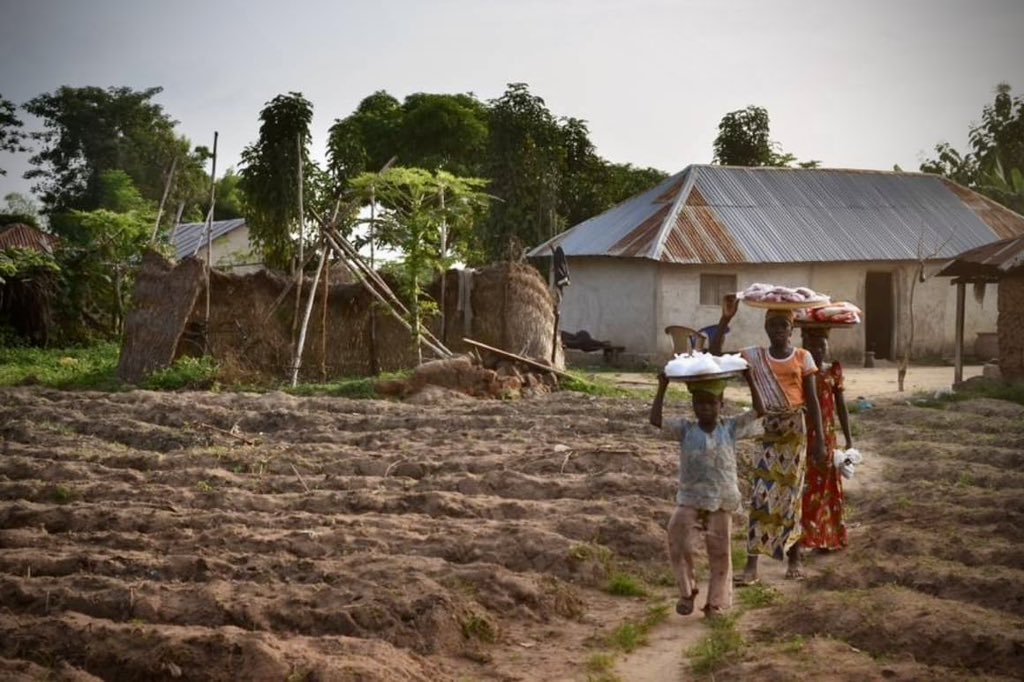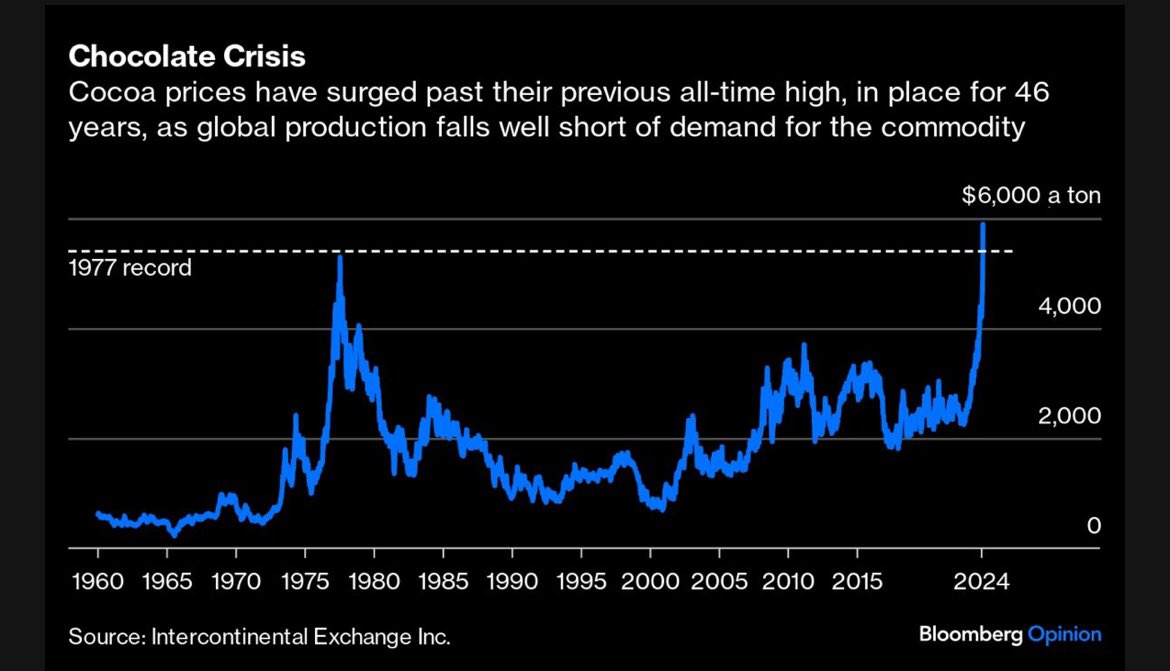🍫🍫🍫THE CHOCOLATE CRISIS — an UPDATED thread🆕🆕🆕:
Retail chocolate prices are rising (and will increase much further, while shrinkflation will reduce sizes) after wholesale cocoa prices surged to an unthinkable all-time high of ***$10,000 a ton*** on Tuesday.
1/15 @Opinion
Retail chocolate prices are rising (and will increase much further, while shrinkflation will reduce sizes) after wholesale cocoa prices surged to an unthinkable all-time high of ***$10,000 a ton*** on Tuesday.
1/15 @Opinion

First, the magnitude of the rally:
In nominal terms, cocoa prices have surged to >$10,000 – up from ~$2,500 a year ago, and ~$650 a decade ago.
To put things into perspective: the previous record, which only fell in February after 46 years unbroken, was ~$5,500.
2/15 @Opinion
In nominal terms, cocoa prices have surged to >$10,000 – up from ~$2,500 a year ago, and ~$650 a decade ago.
To put things into perspective: the previous record, which only fell in February after 46 years unbroken, was ~$5,500.
2/15 @Opinion
Of course, that’s in nominal terms.
In real terms, adjusted by the cumulative impact of inflation, cocoa is still trading well below the peak set in the 1970s.
The record high established 46 years ago equals to ~$27,000 a ton in today’s money.
3/15 @Opinion
In real terms, adjusted by the cumulative impact of inflation, cocoa is still trading well below the peak set in the 1970s.
The record high established 46 years ago equals to ~$27,000 a ton in today’s money.
3/15 @Opinion
To understand the crisis, one has look at its genesis: years of underinvestment in cocoa farming in West Africa, home to ~75% of the world’s supply. Bad weather and diseases added to the problem.
My long-read column from February is below
4/15 @Opinionbloomberg.com/opinion/articl…
My long-read column from February is below
4/15 @Opinionbloomberg.com/opinion/articl…
In West Africa, cocoa is still grown overwhelmingly by poor smallholders. Just making enough to subsist, most lack the means to re-invest in their plots — either by planting new trees or investing in fertiliser and pesticides.
5/15 @Opinion
5/15 @Opinion

Finally, the decades of underinvestment have caught up with growing chocolate demand. Old cocoa trees mean two problems: lower yields, and plants particularly vulnerable to bad weather and disease. Both factors are at play this year.
6/15 @Opinion
6/15 @Opinion
The upshot is a brutal gap between supply and demand. Even when accounting for the damping impact of high prices on consumption, the market is heading for a deficit of 300,000-to-500,000 tons. If confirmed, that would be the largest shortfall in at least 65 years.
7/15 @Opinion
7/15 @Opinion

It isn’t just supply. The current shortfall would be a smaller problem if global cocoa demand hadn’t double over the last 30 years, as the rise of the middle class creates more consumers. And more is coming, as per-capita demand is still low in places like China.
8/15 @Opinion
8/15 @Opinion
Global chocolate consumption (per capita annually), selected countries:
🇨🇭 Switzerland: ~12 kg
🇺🇸 USA: ~9 kg
🇩🇪 Germany: ~6 kg
🇧🇷 Brazil: 1.5 kg
🇮🇳 India: 1.0 kg
🇨🇳 China: 0.2 kg
9/15 @Opinion
🇨🇭 Switzerland: ~12 kg
🇺🇸 USA: ~9 kg
🇩🇪 Germany: ~6 kg
🇧🇷 Brazil: 1.5 kg
🇮🇳 India: 1.0 kg
🇨🇳 China: 0.2 kg
9/15 @Opinion
Supply-and-demand fundamentals were at the genesis of the cocoa price rally. Now, financials factors are accelerating it. And fast.
FREE-TO-READ my latest column (published March 26) to understand the cocoa's financial market plumbing.
10/15 @Opinionbloomberg.com/opinion/articl…
FREE-TO-READ my latest column (published March 26) to understand the cocoa's financial market plumbing.
10/15 @Opinionbloomberg.com/opinion/articl…
Cocoa is hardly an orderly market:
"Once prices become untethered from fundamentals, a bull market is almost impossible to stop — until something breaks. Brace for the current surge in cocoa to have wider ramifications than inflating the cost of your Easter egg."
11/15 @Opinion
"Once prices become untethered from fundamentals, a bull market is almost impossible to stop — until something breaks. Brace for the current surge in cocoa to have wider ramifications than inflating the cost of your Easter egg."
11/15 @Opinion
"Disorderly markets can lead to trading firms struggling, and even collapsing. That’s what happened in the European electricity and natural-gas markets in 2022 [...] It also happened in the cotton market in 2008 and again in 2011"
12/15 @Opinion
12/15 @Opinion
A sign of trouble is the decline in liquidity in the financial cocoa market since January:
The aggregate number of outstanding contracts, known as the open interest, in the New York and London cocoa futures market has fallen by ~35% over the last three months.
13/15 @Opinion
The aggregate number of outstanding contracts, known as the open interest, in the New York and London cocoa futures market has fallen by ~35% over the last three months.
13/15 @Opinion
What’s happening is starting to be felt in supermarkets around the world: rising retail prices and shrinkflation. And more – a lot more– is coming.
Listen to Michele Buck, the boss of Hershey. “We will be using every tool in our toolbox, including pricing.”
14/15 @Opinion
Listen to Michele Buck, the boss of Hershey. “We will be using every tool in our toolbox, including pricing.”
14/15 @Opinion
This thread is an updated version of another one I published in Feb., which ended with a few photos of my cocoa reporting trips over the years.
The link to the old thread is here:
And you can watch a video here:
15/15 @Opinion




The link to the old thread is here:
And you can watch a video here:
15/15 @Opinion
https://x.com/JavierBlas/status/1759597009240047995?s=20
https://x.com/JavierBlas/status/1767668832498221427?s=20




• • •
Missing some Tweet in this thread? You can try to
force a refresh








